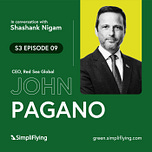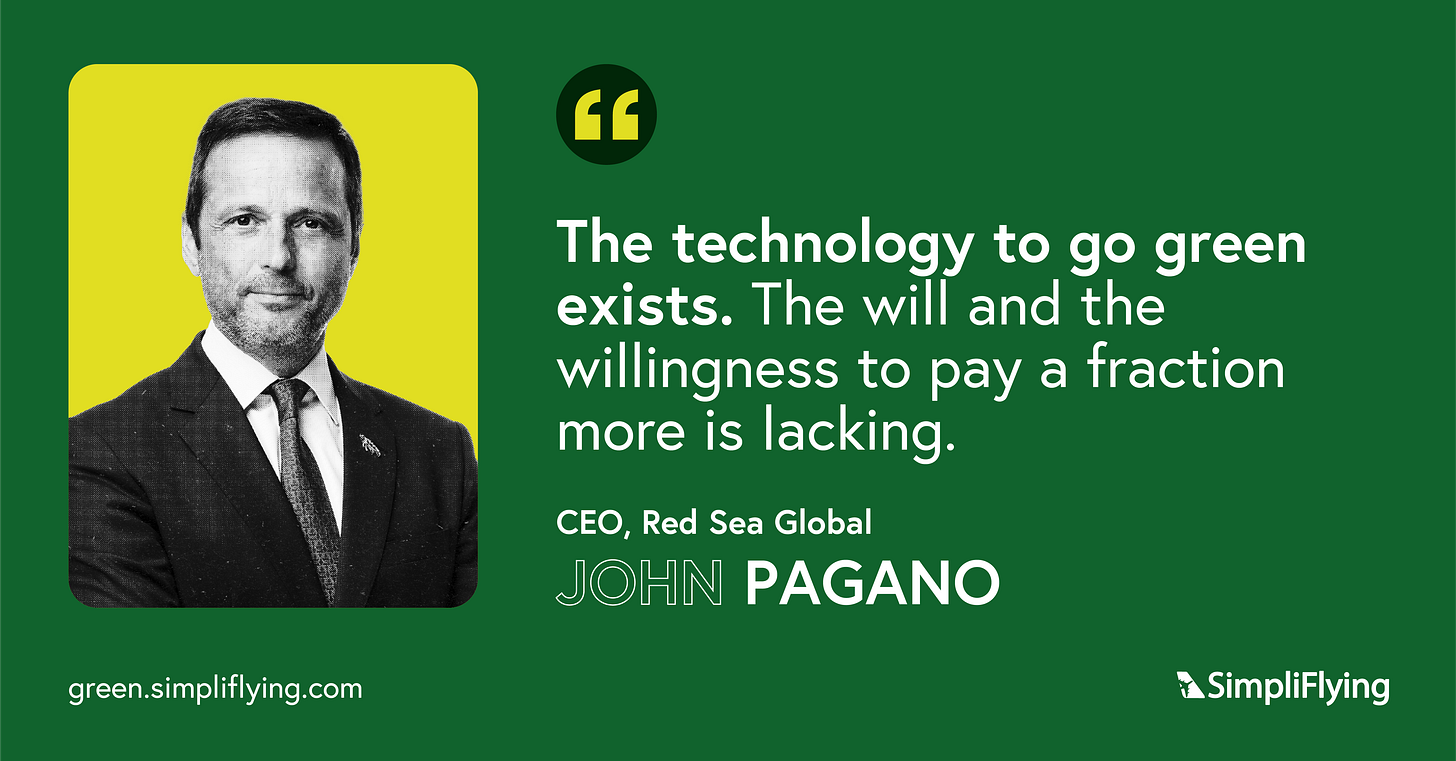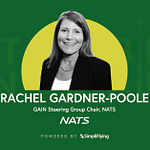Welcome to Season 3 of Sustainability in the Air, the world’s first podcast dedicated to sustainable aviation. Through in-depth conversations with top aviation leaders, we break through the clutter and provide a clear roadmap for a net-zero future.
Despite climate activists’ razor-sharp focus on aviation’s 2.5% CO2 emissions, the wider travel and tourism industry is responsible for 8%-11% of global emissions. Now, multi-project developers like Red Sea Global aim to set a global benchmark for responsible tourist destinations of the future.
Backed by the Public Investment Fund (PIF) of Saudi Arabia, Red Sea Global has been spearheading a new model of tourism development on the west coast of Saudia Arabia. Their portfolio includes two regenerative tourism destinations – the Red Sea and Amaala – both built to not only protect the natural environment, but also to enhance it for future generations to come.
In this episode of our ‘Sustainability in the Air’ podcast, Red Sea Global’s CEO John Pagano speaks with SimpliFlying CEO Shashank Nigam and shares how the developer is rethinking eco-tourism that will allow you to travel not just net-zero, but true climate positive.
You can listen and subscribe to our podcast on all major podcast platforms or read our deep dive into the episode below.
If you’re rushed for time, you can also directly jump to your topic of interest by referring to these timestamps:
The need for sustainable tourist destinations (8:05)
Going 100% renewable 24 hours a day (10:32)
About batteries and energy storage (15:44)
The importance of blue carbon and natural capital (20:04)
The hydrogen debate: technology vs infrastructure (30:50)
Setting an ecological ceiling to preserve the environment (33:04)
Why transparency is the key to setting and achieving goals (38:25)
Rapid Fire! (43:48)
The Prodigal Sun
Eco-tourism, of course, is not a new concept. On the face of it, Red Sea Global’s resorts are ostensibly what they claim to be — a great way for people to unwind and explore a new destination with minimal impact on the planet. However, at its heart, the business is a challenge to the established hegemony of profit-driven and ultimately catastrophic capitalism.
By re-thinking the entire model of what tourism can be — and should be — in the future, Red Sea Global is on a mission to prove that good business can go hand-in-hand with a greener planet. As Pagano says, we know what we’ve done wrong in the past, and we know the reasons for the current climate and ecological crisis. And it’s up to us to not repeat those mistakes.
It began with seemingly small but radical decisions. For example, while renewable energy was always on the cards, Pagano went a step further and completely disconnected from the grid. “The early advice I got from our engineers was to go solar, produce energy during the day, send excess power into the grid and then draw that power back at night,” recalls Pagao. “But that would be a bit of a fraud, right? Because what I send to the grid in the morning doesn’t come back to me at night.” Instead, Pagano decided to go 100% renewable by investing in the most freely and abundantly available energy source in the Kingdom: the sun.
“We are now creating the largest tourism destination in the world that is powered 100% by renewable energy 24 hours a day. We are also the largest microgrid in the world and are building the biggest battery storage system in the world today, at 1.2-gigawatt hours or 500-megawatt hours,” states Pagano.
Pagano believes that the COVID-19 pandemic has put the climate crisis in sharp focus. People are increasingly looking to travel sustainably. “We’re trying to demonstrate that customers will pay an extra dollar per night if they know their stay will not have a carbon footprint,” he says. “This is not just a feel-good sentiment but also the right thing to do for the planet.”
Setting an ecological ceiling
Unusually for an industry that thrives on sheer volume, Red Sea Global aims to limit the population they want to bring to the destination. While discussing the upcoming Red Sea Airport that will serve the Jeddah resort, Pagano mentions that it was designed to handle only a million passengers per year.
“We have a slight dilemma that we don’t want to be a mass tourism destination,” Pagano explains. He says that they’re consciously self-limiting the development to limit the number of people who can visit per year. In fact, only 1% of the 28,000 square kilometre site will actually be developed. Pagano adds context by saying that since the site is the size of Belgium, there was never a question of developing more than a fraction of it in any case.
“We determined early on what our ecological ceiling was. And we don’t believe that we can accommodate more than a million people without damaging the environment.”
Increasing the net conservation value
Red Sea Global’s approach is remarkable in its holistic approach to environmental conservation. Apart from pristine, unexplored land, the site also includes an archipelago of 90 islands — more than 2,500 square kilometres of marine environment.
In order to preserve and protect it, Red Sea Global undertook an extensive marine spatial planning simulation — the largest ever in the world. “We divided the entire marine environment into 30,000 squares and assigned conservation values to each,” he states. “Through that process, we tried to determine how many people we could accommodate to not just sustain the environment but to actually enhance it.”
As a result, Pagano says they set an ambitious goal to actually increase the net conservation value of their destination by 30% over the two decades. He adds that this would actually be an improvement over simply leaving the site untouched. It is through various evaluations like this that they reached the ecological ceiling figure of one million.
“We will deploy sensors to measure the threat to our environment. We’ll have real-time monitoring using artificial intelligence and machine learning to get early indications of anything that’s not going to plan.”
Nothing to hide
Ultimately, Pagano wants the flexibility to adjust the ecological ceiling and approach to managing the destination if the data demands it. However, he admits that demonstrating and proving the numbers is much harder than making bold statements about sustainability initiatives.
In order to prevent accusations of greenwashing, Red Sea Global has chosen to be completely transparent about their data and initiatives. “We’ve done the most extensive baseline survey ever undertaken by a private developer,” says Pagano. “Rather than just keep that to ourselves, we’ve published it for anyone to see.”
Red Sea Global also publishes their own sustainability report. Each successive report aims to monitor and report their performance against their goals. “Our goal is to do better, but we will do it on an open book basis where people can see and judge us for what we are,” says Pagano. “If we’re not achieving it, they’ll know we’re not achieving it, but they’ll know for sure that we’re trying our utmost to make it happen.”
Ultimately, Pagao accepts they may fail in some areas. But he says they have no qualms in failing transparently because that will increase the confidence and belief in what they’re doing. “Everybody talks about what we’re going to do, but very few people are actually doing it,” says Pagano. “We want to be in the camp of doing — and we actually are. That’s what we’re proud of because if more people see others doing, they’d be compelled to do something themselves.”
Our Take
In a fascinating conversation, one of the most interesting bits comes right at the beginning. It is a refreshingly honest appraisal of why Red Sea Global is likely to succeed.
Consider what Pagano says: “We’re funded by the public investment fund; we don’t have the usual commercial constraints and drivers of short-termism and short-term profit. I don’t have shareholders saying to me: where are my returns, where are my dividends. So we could take a much longer-term view and do things better. As we got further into it, I saw the opportunity to lead not only what we were doing in the Kingdom and in the region, but to actually be the leaders in a global transition.”
So here it is, the elephant in every company’s sustainability conversation – how are we to succeed if we cannot survive commercially?
It is a difficult but urgent question that must be reckoned with. One potential answer lies in how Saudia Arabia’s Vision 2030 – with sustainability as its centrepiece – has gained momentum because of the Crown Prince Mohammed Bin Salman’s personal interest in it. Across the globe, innovative solutions to the climate crisis are cropping up but face significant challenges in acquiring capital to bring a viable solution to market.
This is where governments can step in to support and collaborate with businesses. If the government of the UK, for instance, can issue a controversial new mining permit, the least it can do is cough up funding for green projects as well. The IPCC’s latest report already warns that our current trajectory is way off in terms of limiting global warming to 1.5 degrees above pre-industrial levels by 2050. If governments and regulators still cannot get their act together to collaborate, increase climate funding, and de-legitimise fossil fuel usage, catastrophe is certain.
The most telling bit of the IPCC report says: there is sufficient global capital and liquidity to close global investment gaps. As Pagano says in the podcast, the climate crisis does not lack solutions; it lacks the will and willingness to act upon it.
Our Sustainability in the Air podcast is powered by SimpliFlying which has been helping build trust in travel for over a decade.
This season of the podcast is brought to you by Cirium and CarbonClick. As a sustainability partner, Cirium helps the aviation industry gain a much clearer view of carbon emissions and develop methods to reduce them, enabling on the industry promise to fly sustainably. CarbonClick is the industry leader in managing transparent carbon offsetting programs for individuals and top global airlines.














